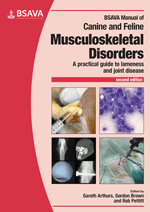
Full text loading...

Arthroscopy is particularly useful in those cases where lameness is associated with little or no clinical or radiographic evidence of pathology. This chapter covers general indications for diagnostic arthroscopy, the surgical team, patient preparation, general arthroscopic procedure, the arthroscopic image, visible intra-articular structures and their appearance, and complications and problems.
Arthroscopy, Page 1 of 1
< Previous page | Next page > /docserver/preview/fulltext/10.22233/9781910443286/9781910443286.15-1.gif

Full text loading...

















